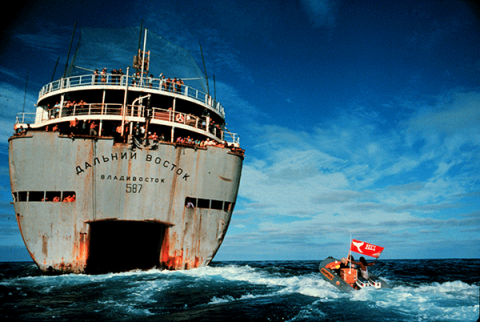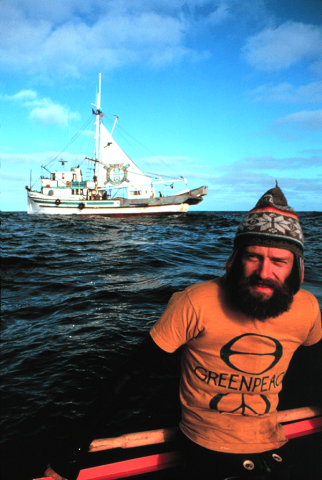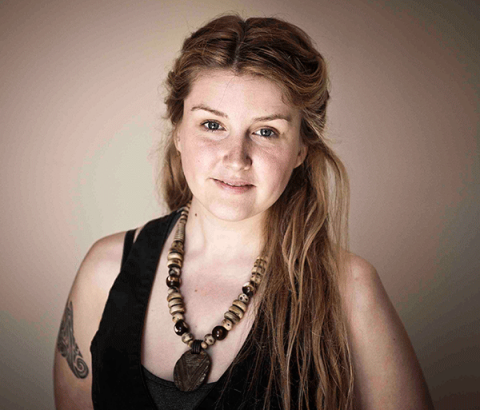
Trying to change the world does not exempt anyone from criticism. Take Greenpeace. The Canadian-born, now-global environmental organization, whose beginnings are documented in the new film How to Change the World, has spent more than 40 years trying to effect positive change on the planet, from protesting nuclear testing to saving the whales to taking action against the spread of genetically modified organisms (GMOs).
But the group came under attack last December when Greenpeace members entered the site of Peru’s famed Nazca lines and placed large yellow cloth letters spelling out “Time for Change! The Future Is Renewable” beside the giant stylized figure of a hummingbird. The Nazca lines are estimated to be over 1,500 years old and consist of a series of line figures visible only from the air. The site is fragile and the government accused the trespassers of irreversibly disturbing the site. Public backlash was vitriolic, and Peruvian deputy culture minister Luis Jaime Castillo called it “a true slap in the face at everything Peruvians consider sacred.” Greenpeace apologized and turned over the names of four of those involved. But Emily Hunter thinks we should cut Greenpeace some slack. The self-identified “environmental media activist” and daughter of late Greenpeace co-founder Bob Hunter says that the organization is learning from its mistakes and is willing to change, so the public should be willing to forgive.
“Yes, there have been mistakes made, even in recent history,” she tells Samaritanmag. “But at what point do we, as the public, start forgiving and start supporting someone and something that is still trying to do some good in the world? We’re so easy to criticize. We won’t see when people are trying to correct themselves and evolve and take the right steps, and that’s where Greenpeace is going. And so I do still support them, despite the Nazca lines” incident.
As shown in director Jerry Rothwell’s documentary, there was a time when Greenpeace was practically beyond reproach. The group had its roots in the late ‘60s anti-war and environmental movements in both American and Canada. Members of both groups, as well as a new generation of young activists, coalesced around the issue of U.S. nuclear tests on the island of Amchitka in 1969. Many of them gathered in Vancouver and their cause was righteous.
Vancouver Sun columnist Bob Hunter became one of those activists, hooking up with a motley assortment of ecologists, sailors, photographers, hippies, American war resisters, and scientists to hire a boat to sail to Amchitka. Hunter cannily kept media apprised of their efforts and the dangers they faced, which included weather and run-ins with American immigration officials. His idea of changing minds globally on an issue through compelling stories and images became known as a ‘mindbomb.’
“My father coined the term ‘mindbomb,’ which is much more than you think today of ‘going viral,’” says Emily. “But it’s actually being able to use our minds as our greatest tool of revolution, and that’s really what he meant by it.
“He did this in a couple of ways, by creating stories and events that would help to shift the public mindset and disseminate those stories through mass media in the early broadcast area. And he really felt it was the story that we tell ourselves that can shape minds, shape cultures, and, ultimately, shape society. Because we are constantly told a story today of crisis, and doom and gloom and fatalism, that somehow something like the oil industry is untouchable and inevitable, and the fossil fuel regime is inevitable, for example, in today’s situation. If we keep buying into that story, we stay passive, we stay controlled, and, quite frankly, we allow the destruction of our atmosphere to continue on.
“Rather we can tell ourselves a new narrative, one of empowerment, one of ordinary people doing extraordinary [things] and changing our world for the better, and that it’s always people who have shaped history and shaped the world. And if we tell ourselves those stories, well, that tells us a completely different role of our place in the world and what we can do in our world.”

Emily, 31, began her own activist career as her father’s health began declining in the late ‘90s. (He died of prostate cancer in 2005.) She started out as a member of Watson’s Sea Shepherds, an organization notorious for ramming whaling boats, before embarking on her own career as a writer, documentarian and activist. That has meant using new school activist tools like social media and blogging as a means of effecting change in addition to (or instead of) old school ones like campaigning and protesting.
“Today we have more democratic tools available to us; media tools that are more democratized than before, everything from Twitter to your own blog to social media to crafting your own videos and releasing them on YouTube. There’s now a new app called Periscope where you can livestream a story or an event in real time,” she says.
“So no longer is the media only in control of the message, as it’s become very clear over the last two decades. Instead, now we can tell a story about what’s happening in the field in real time. And I think that’s more important than ever because we have a variety of issues that we’re facing, and we need different stories to be told that aren’t being told about what’s happening to our planet, what’s happening to people, the injustices that are happening, and we need new voices telling them.”
Much of the drama in How to Change the World stems from the philosophical divide that grows between Bob Hunter, Peter Moore and Paul Watson as they attempt to derail the seal hunt off the coast of Newfoundland in April 1978. Watson is young (he was 19 when he started with what became Greenpeace) and arguably hot-headed. He wants to spray paint the seal pups — the targets of the hunt — rendering their pelts worthless. Hunter instead listens to the concerns of the hunters, most of whom rely on the hunt for the bulk of their annual income, and unilaterally decides that members of Greenpeace will not spray them.
An incensed Watson would increasingly find himself at loggerheads with Moore, who had taken over leadership of Greenpeace from a stressed Hunter in early 1977. Eventually Watson split from Greenpeace to found the Sea Shepherds, an organization that would not hesitate to save seals and other wildlife via direct and aggressive action, hence the whaling ship ramming.
Emily, who is a member of (and freelance contractor with) Greenpeace and still admires Watson, appreciates the tactics of both organizations.
“I think it takes different tactics for different situations, and I think for Sea Shepherds it is necessary to use those kinds of aggressive tactics out in the ocean to save whales,” she says. “Quite frankly, we tried everything and anything in terms of stopping the Japanese whaling fleet and they continued to go out there year after year. Even after what I mentioned with the international court, they are still going against those international courts and continuing to whale.” [For years the International Whaling Commission has censured Japan, whose government took over whaling from commercial interests back in the ‘80s, for whaling illegally.]
“So if an industry and a government are going to be that aggressive in killing off a population, killing off a species, then I think environmentalists also need to be able to be on that defensive.”
Of course, as Emily notes, when it comes to the battle on climate change, there is no boat to ram.
“I wish it was like that. I wish it was that tangible. But the reality is it is our whole atmosphere and whole fossil fuel-based economy we’re up against. And for that fight we need creative tactics; we need non-violent tactics. We need tactics that will build up a network of people to show them the moral compass on this issue.
“And that is being had in a variety of ways that don’t include the Sea Shepherd tactics, and Greenpeace and others are leading that front. But they’re using other tactics, whether it’s digital or online; whether it’s getting influencers, even Pope Francis, on board; whether that’s divestment or global days of action. You name it, we need more of that stuff to happen in the global climate battle.”
Of course those tactics are going to bring resistance from the powers being challenged. In the ‘70s that meant Russian whalers throwing harpoons over Bob Hunter’s head as he tried to protect whales by placing himself in a tiny boat between them and the ships, a dramatic scene depicted in How to Change the World.

And as recently as 2009, it meant Emily allegedly being threatened by operatives of our own government.
“I guess what was most jarring for me in my career as a media activist was when I was doing a short documentary with MTV Canada back in 2009,” she says. “I was doing a short documentary on the tar sands, and that’s when it wasn’t that big an issue as it is today with the Keystone Pipeline and Energy East. I went with just one camerawoman and myself and maybe a budget of $2,000. Not a huge threat exactly.
“And I got threatened essentially by affiliates of the government. I had written a blog about the tar sands and about First Nations people, about their whole way of life being transformed. And as we were on our way to do this filming, I started getting a blog moderator [of] the Alberta government telling the online magazine that posted my blog to take it down, and [they] threatened to sue us if we didn’t take the blog down. Everything I had written was factual, everything was based on this woman’s experience, and I quoted her and it was her story. And so my editors stood behind me and didn’t take it down. And in fact we posted what the government put out and it created a whole conversation, like a viral conversation, and it was great.
“But it was a bit jarring that the government would go to this level, that they would have a blog moderator threatening to sue me over a piece about the tar sands.”
But that was not the end of the story.
“I felt during the filming process that we were being followed,” Emily says. “And so maybe that’s just me being paranoid but there was definitely a black car watching us, following us, every move we were going. Just stuff like that I thought was really extreme on the government’s part, trying to censor journalists and activists from bringing attention to this issue in the early days. So that kind of stuff is very surprising when we live in a so-called democracy.”
Asked how one can combat those tendencies in our own government, Emily is clear: get involved in the upcoming Canadian election and vote out the Conservatives.
“This vote is extremely important,” she says. “I think getting out there, getting organized and getting involved with this election is going to be the next big push for a lot of us. And there’s a lot of ways to do that, from votetogether.ca with Leadnow; they’ve got a strategic voting campaign. GreenPAC is also out there trying to advocate for Green Party leaders. There’s a number of groups who are organizing around this next federal election to become involved with.”
And for those inspired by How to Change the World, yes, Greenpeace, among other organizations, is a good place to start, says Emily, even if it is not the same organization her father helped to found. But that, she says, is a good thing.
“As my father put out in the film: let the power go. And what that really was was letting the movement go and letting the brand go and letting control of all of it go. And you need to be able to let a movement grow and expand and evolve and shape and adapt to the time, especially in the 21st century, if it’s going to survive.
“So I’m glad it’s not the same organization. I do think we are going back to some of the original values. I do think it’s going back to the grassroots and it’s trying to enable people to become their own activists. I do see some of the same values coming back, and that’s exciting to me.
“But I do think it’s a good thing that the organization is continually evolving. We can’t just stay as a 1970s organization. It’s 2015 and we need a 21st century organization.”
But at least the beards are the same. She laughs.
“The beards are the same, yes.”
Gifts for Runners